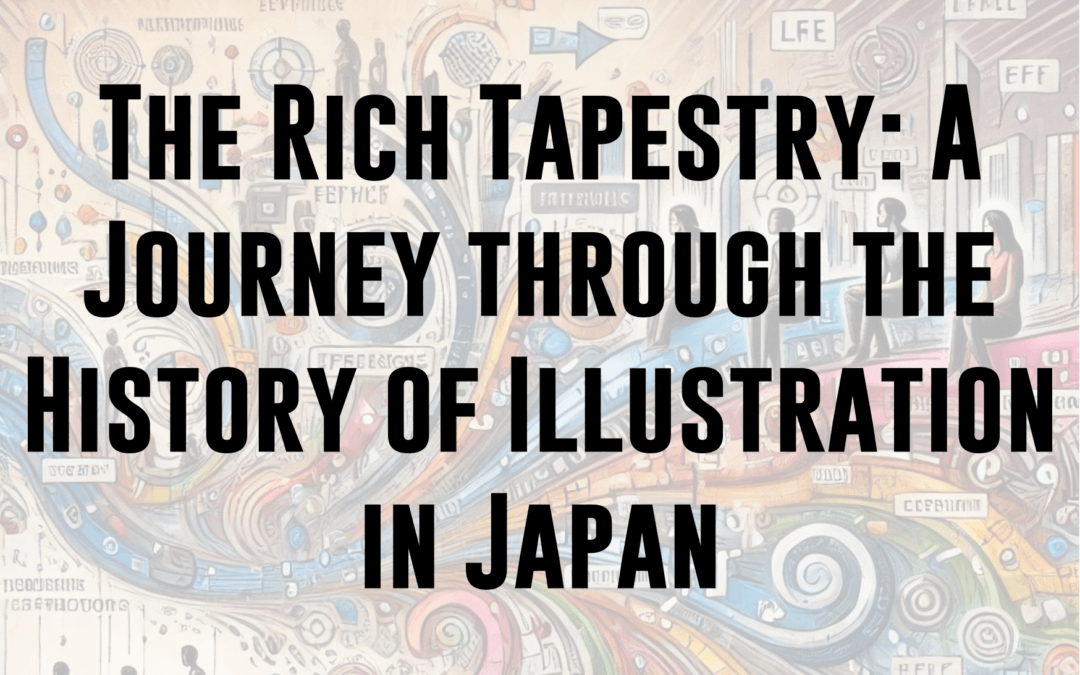Illustration in Japan is a captivating tapestry woven with threads of tradition, innovation, and cultural significance. From ancient scrolls to modern manga, Japanese illustration has evolved over centuries, reflecting the country’s rich history, beliefs, and artistic expressions. Let’s embark on a journey through time to explore the fascinating history of illustration in Japan.
The Early Influences:
- The roots of Japanese illustration can be traced back to the country’s early history, heavily influenced by Chinese and Korean artistic traditions.
- Emakimono, or picture scrolls, emerged during the Heian period (794–1185), depicting narratives through painted scenes unrolled horizontally.
- Notable examples include the “Ban Dainagon Ekotoba,” illustrating scenes from “The Tale of the Heike,” and the “Genji Monogatari Emaki,” portraying episodes from “The Tale of Genji.”
The Rise of Ukiyo-e:
- Ukiyo-e, or “pictures of the floating world,” flourished during the Edo period (1603–1868), characterized by woodblock prints depicting scenes of daily life, landscapes, kabuki actors, and beautiful women.
- Artists like Hokusai and Hiroshige became synonymous with this genre, producing iconic works such as Hokusai’s “Thirty-Six Views of Mount Fuji” and Hiroshige’s “The Fifty-Three Stations of the Tōkaidō.”
- Ukiyo-e prints not only served as decorative art but also influenced Western artists like Vincent van Gogh and Claude Monet during the Japonism movement in the late 19th century.
Modernization and Western Influences:
- The Meiji Restoration (1868) brought about rapid modernization and the opening of Japan to the West, influencing various aspects of Japanese art, including illustration.
- Western-style painting gained prominence, but traditional Japanese themes persisted, merging with new techniques and styles.
- Notable illustrators like Yokoyama Taikan and Kawanabe Kyōsai navigated this period of transition, blending Eastern and Western elements in their work.
The Birth of Manga:
- Manga, a distinctive form of Japanese comic art, emerged in the late 19th century, influenced by traditional art forms like ukiyo-e and modern Western comics.
- The publication of Rakuten Kitazawa’s “Jiji Manga” in 1902 is often regarded as the starting point of modern manga.
- Manga gained popularity across demographics, evolving into diverse genres, including shōnen (boys’) manga, shōjo (girls’) manga, and gekiga (dramatic pictures).
- Pioneers like Osamu Tezuka, often referred to as the “God of Manga,” revolutionized the medium with works such as “Astro Boy,” introducing cinematic storytelling techniques and complex characters.
Contemporary Trends:
- In the digital age, Japanese illustration continues to thrive, encompassing a broad spectrum of styles and formats.
- Manga remains a global phenomenon, influencing artists worldwide and expanding into digital platforms and multimedia.
- Contemporary illustrators like Yoshitaka Amano, known for his ethereal and detailed artwork, and Naoki Urasawa, celebrated for his intricate storytelling, push the boundaries of the medium.
- Illustration in Japan today reflects a blend of tradition and innovation, with artists drawing inspiration from diverse sources while staying rooted in the country’s rich cultural heritage.
Conclusion:
The history of illustration in Japan is a testament to the country’s artistic ingenuity and cultural resilience. From ancient scrolls to modern manga, Japanese illustration has evolved, adapted, and flourished, leaving an indelible mark on the global art scene. As we continue to explore and appreciate its diverse expressions, we honor the legacy of creativity that has shaped Japan’s visual narrative for centuries.
